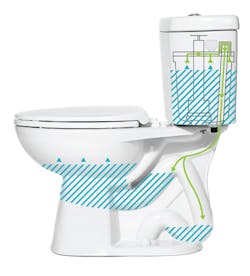Above, a Niagara toilet with Stealth technology.
Niagara Conservation had its start in 1977 when the corporation’s founder, Bill Cutler, developed his first showerhead while tinkering in his garage. Forty years later the company has grown from a one-man operation to a multi-million organization that is an industry leader in water saving toilets, showerheads and aerators.
CONTRACTOR sat down with Richard Rossi, Business Development Manager for Niagara, to talk about the state of water saving technology from the manufacturer’s perspective.
CONTRACTOR: What kind of water savings can a standard household expect over the course of the year if they go from a standard, 1.6. GPF toilet to a high performance toilet?
Rossi: Using a WaterSense standard, that is, a three-person household averaging five flushes of the toilet per day per person, we estimate that over a 1.6 GPF toilet you're going to go from about 8,800 gallons annually to about 4,400. So obviously you're going to cut that in half, which we see in the marketplace quite a bit.
We play quite a bit in the multifamily space, and there are an amazing amount of 3.5 GPF toilets still in use, and many of the older apartment buildings have a ton of them. So we've been huge in renovation and retrofitting over the years. You can save upwards of 15,000 gallons annually with a Niagara, versus a 3.5 GPF toilet under that same standard (three-person household, five flushes per person)… that’s [enough] to fill out an 18 by 40 ft. in-ground swimming pool on an annual basis, which is about 20,000 gallons—pretty significant.
CONTRACTOR: That savings has got to sound great to almost any facility manager—but that same manager is going to be worried about dependability, about how many calls their maintenance crew are going to respond to over a year.
Rossi: Some of our toilets are built with Stealth Technology that uses vacuum-assisted flush instead of traditional gravity-fed with a flapper, so there's no rubber flapper and chain mechanism in these toilets… The toilets very rarely fail or create any leaks. The flapper is what causes most maintenance issues because it wears down quickly. Our Stealth Technology utilizes a silicone seal that's on the bottom of the flush tower and it's pressed flat under hard plastic. So that is what seals the water in the tank… And then you have a 360-degree Water flow which helps to clear the bowl with a small amount of water. So, the bottom line is reliability and flush performance are excellent with our low-flow toilets thanks to the completely different technology…
[Keep in mind,] it's the presence of the other long duration water flow sources in a building—showers, clothes washers, your dishwasher, etc.—all of those things continue to move that waste down the drain line. So, if it's a really older property, and they're already having issues with plumbing, then that's something we'd want to have a plumbing engineer do some analysis on to see if it's appropriate to use an under one gallon toilet for that application…
[Our] toilets have been out on the market ten years. I know people that have our original toilets that came out 10 years ago and they've never had to change it or perform maintenance... The other thing we’ve talked to building managers about is our warranty. We provide a 15 year warranty on all parts in the tank, all what we call the tank trim… So that's how confident we are about the maintenance on these toilets and the lack of failure of the parts.
CONTRACTOR: How is Niagara, as a manufacturer, trying to help system designers working to build eco-friendly buildings?
A lot of it depends on the building certification that they're trying to achieve… but there are credits available for outdoor watering, and also for innovative wastewater technologies… you're going to get at least two [LEED] points for water use reduction on the property as well. So that's a factor reducing Water usage by an average of 20 percent from whatever they consider that baseline to be…. I've actually heard of projects or they can get up to four points by using a toilet that’s 0.8 GPF…
We work with a lot of developers that are spec-ing toilets. But on a many of those projects, if they are trying to achieve any type of green building certification—be it LEED, the national green building standard and so forth—many developers will hire a sustainability consultant in essence to work with the owner to maximize the amount of points toward that building certification. And that can benefit the owner in many ways. In some cases, they can get more competitive lending on their money or even “green” loans. So that helps them on the front end… One of the things that we're finding is a real trend in the industry right now, because Water, so scarce especially in the western United States… in many of those cases, we're able to help a developer to reduce what they call tap fees or impact fees on the property which is basically an upfront charge for building in that municipality… we could possibly help developers save hundreds of thousands of dollars in impact fees on a multifamily property.
About the Author
Steve Spaulding
Editor-in-Chief - CONTRACTOR
Steve Spaulding is Editor-in-Chief for CONTRACTOR Magazine. He has been with the magazine since 1996, and has contributed to Radiant Living, NATE Magazine, and other Endeavor Media properties.


